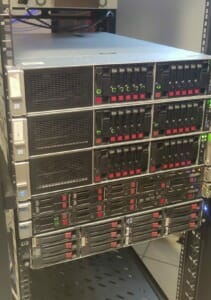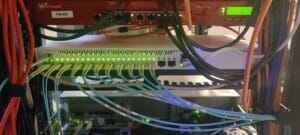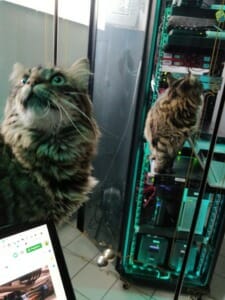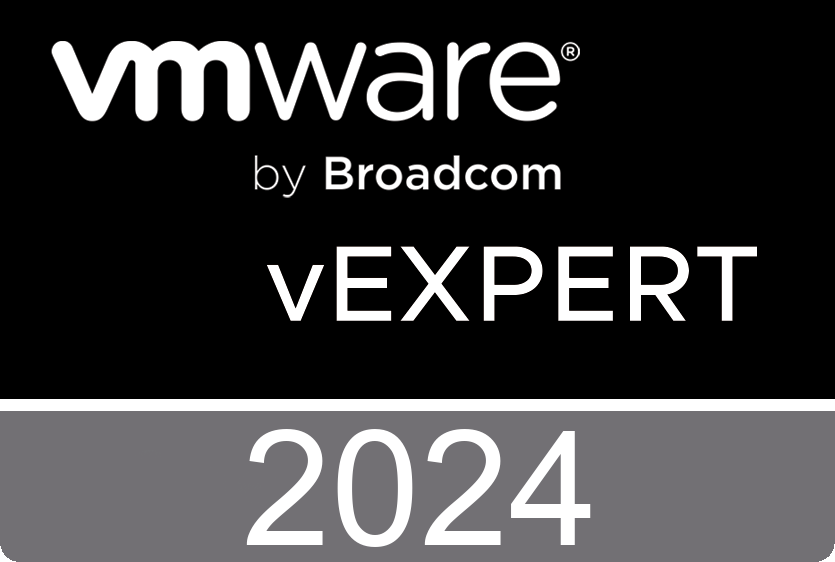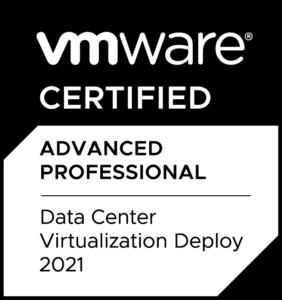HomeLab
(Last update: 2023-10-07)
My HomeLab is split across multiple locations.
HomeLab #1: Germany, Frankfurt
This lab is a colocation at meerfarbig, hosting the more public-facing workload.
Host specifications:
- Model: HPE ProLiant DL380 Gen9
- CPU: 2x Intel Xeon E5-2673 v4 @ 2.30GHz (40 threads)
- RAM: 384 GB DDR4 RAM (12x 32 GB)
- Boot: Samsung 980 500 GB NVMe M.2 via NVMe PCIe x16 Adapter
- Disks (via HPE Smart Array P840ar)
- 4x HPE 1.2 TB SAS HDD (vSAN Capacity Disks)
- 1x Micron 5300 Max 960GB 2.5 (vSAN Cache Disks)
- Disks (via HPE Smart HBA H240)
- 4x HPE 1.2 TB SAS HDD (vSAN Capacity Disks)
- 1x Micron 5300 Max 960GB 2.5 (vSAN Cache Disks)
- Dual PSU
- NICs:
- 2x HP Ethernet 1Gb 4-port 331i Adapter
- 1x HP Ethernet 10Gb 2-port 530 FLR-SFP+ Adapter
- Running VMware vSphere ESXi 7.0
HomeLab #2: Austria, Lower Austria
This might be the longest bit. It started with a HPE MicroServer Gen8… and somehow… it escalated quickly.
Compute cluster
Main workload
Two hosts, each one with following specs:
- Model: HPE ProLiant DL380 Gen9
- CPU: 2x Intel Xeon E5-2667 v4 @ 3.20GHz (32 threads)
- RAM: 320 GB DDR4 RAM (10x 32 GB)
- Boot: Samsung 980 500 GB NVMe M.2 via NVMe PCIe x16 Adapter
- Disks (via HPE Smart Array P840ar)
- 10x HPE 1.2 TB SATA HDD
- 2x Micron 5300 Max 960GB 2.5 (vSAN Capacity Disks)
- Dual PSU to two independent UPS, with TPM 2.0
- NICs:
- 2x HP Ethernet 1Gb 4-port 331i Adapter (VM traffic)
- 1x HP Ethernet 10Gb 2-port 530 FLR-SFP+ Adapter (NSX, vSAN)
- Running VMware vSphere ESXi 7.0
Test cluster
This cluster is mainly for testing purposes and running vSAN 8.0 ESA.
Two hosts with specifications as follows each:
- Model: Intel NUC BXNUC10I7FNH2
- CPU: Intel Core i7-10710U
- RAM: 2x Crucial CT2K32G4SFD8266 32 GB DDR4
- Disks
- Storage 1: Samsung SSD 980 1TB (vSAN Capacity)
- Bootmedium: INTENSO 120 GB SSD (ESXi OS)
- Network
- 1x 1 GBe built-in, Management
- 2x 1 GBe USB-NICs StarTech USB 3.0 to Dual Port Gigabit Ethernet Adapter via USB-C (using USB-NIC-Driver-Fling). Using for iSCSI and vMotion.
- 1x 2.5 GBe USB-NIC Club 3D USB 3.2 Gen1 Adapter Type A to 2.5 Gigabit Ethernet for vSAN traffic.
- Running VMware vSphere ESXi 7.0 U1 (7.0 works out-of-the-box, also check out HomeLab 7.0 considerations by William here)
Storage
-
Storage NAS
- Model: QNAP TS-H973AX
- Storage:
- Capacity: 5x Western Digital Red 10TB (RAID6/RAIDZ2)
- Write-Cache: 2x SAMSUNG SSD SM883 240GB (ZFS LOG)
- Read-Cache: 1x Micron 7300 Pro U.2 800 GB
- Various Temp Data: 1x Western Digital SSD 2 TB
-
Backup NAS
- Model: Synology DS920+ 4 Bay Desktop NAS Enclosure
- Storage: 4x Western Digital WD40EFRX 4 TB in SHR-RAID (similar to RAID5, 12 TB useable space)
- Read cache: 1x Samsung 860 EVO 250 GB SATA M.2
Network-wise:
Beside the hardware-wise isolation (Core/SAN), there are also about 15 VLANs across all switches to isolate various workloads from each other.
-
Core Switch
- Model: 2x HPE Aruba 2930F-24G-4SFP Switch (JL259A)
- Those two switches are running in a VSF stack, so they are clustered for increased reduncancy.
- Purpose: Main switch handling all workload like traffic from/to virtual machines, Internet traffic and OSPF/BGP to/from firewall. Uplink over fiber-optic cable to upper floor. Servers are wired to both switches for increased redundancy. LACP in use with Virtual Distributed Switches on the ESXi hosts.
-
SAN Switch
- Model: MikroTik CCR2004-1G-12S+2XS (12x 10 GBe, SFP+ + 2x 25 GBe)
- Purpose: Mainly handling storage traffic for iSCSI, NSX-T, vSAN and vMotion.
-
Management Switch
- Model: HPE Aruba 2920-24G-4SFP Switch (J9726A)
- Purpose: Handling management traffic like iLO to each HPE server, internet traffic from/to modem in separate VLAN, access points, Raspberry Pi GPS time server, etc. There is a uplink of 2x 1 GBe fibre-optic cable to the Core Switch.
-
Firewall
- 2x WatchGuard XTM 525 Appliances (unfortunately EOL)
-
Access Switch
- Model: NETGEAR GS110TP 8 Port PoE Gigabit Smart Managed Pro Switch
- Purpose: This switch is for connecting upper floor (where fiber-optic cable from basement is connected to) and below two switches to handle e.g. client traffic.
-
Client Switches
- Model: 2x NETGEAR GS108Tv2 8-Port Gigabit Smart Managed Pro Switch
- Purpose: Handles media area (TV/Xbox) and office (1x PC and 1x network printer)
Running following VMware products:
- VMware ESXi + vCenter
- VMware vSAN
- VMware NSX
- VMware NSX Advanced Load Balancer
- VMware Horizon
- VMware Unified Access Gateway
- VMware AppVolumes
- VMware vRealize Log Insight
- VMware vRealize Operations Manager
- VMware Cloud Director
- Carbon Black
And in case you’re wondering: Yep, these are indeed 2x Philips Hue Light Strips for some cool lighting. Because of reasons.
Also, here are some pictures:
